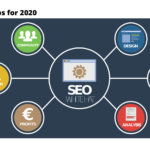Jimmy Does Daycare Advertising Ideas &
"A Real Analysis on Local Daycares"
If you watched the video you’ll know what is going on with the image below. After reviewing “daycare Los Angeles”, you can see the way that people are searching and also what Google is saying is important to the search. One of the first things you’ll see is the Google Maps grid or Google My Business. This is where businesses will tell Google where they are located such that their business shows up on Google Maps. In today’s world where location and distance are of utmost importance, Google My Business and having a strong presence on Google My Business is important. After the maps, you’ll see questions people are asking frequently; these would be good questions to answer yourself and have on your website as it is what people are looking for in relation to daycares. Lastly, you’ll see the organic map listing and this is where your website landing page can show up for a specific search. This is just reviewing Daycare SEO; it’s simply one idea or one of the ways you can market your business online.
For a long time, advertising for daycare centers was dominated by physical marketing tactics such as putting an ad in the paper or flyers on bulletin boards at local schools. Although these methods are still in use, and may continue to provide value in certain areas, the reality is, in this day and age, most parents are looking for daycare options for their kids online.
If you’re thinking, “Oh, I know. I have a website”—hold on a second. Although having a website for your daycare is a great start in the online marketing process, it’s no longer the only online outlet for daycare centers to generate leads. Check out my Los Angeles SEO services or New York SEO Services for example pages which are my main lead generation pages to this day with SEO only! In fact, there are multitudes of ways your daycare should be utilizing the internet to attract more clients. Curious? Keep reading to learn six essentials tactics your daycare center can use to generate more leads and help turn parents who are “just looking” into loyal clients.
Why Does Daycare Advertising, Daycare SEO & Digital Marketing matter?
Local businesses, including daycares, used to heavily depend on physical or manual methods of lead generation and marketing to grow the businesses. However, not only were these methods time intensive and capital intensive, it required a lot of work on the part of the daycare to do push marketing to bring leads.
However, the beauty of today’s marketing is that it can be significantly digital.
New families, moms, dads or caretakers that are looking for a daycare no longer have to look for signs or simply rely on a referral. They can easily just Google “daycare” or “daycare” + their city to find a slew of options that are close to them and can provide a service.
This footprint online, whether it is ranking your website page or ranking your Google My Business to show up for locality searches or running ads on Google or Facebook have now ushered in a much easier method of raising awareness, branding and availability.
However, the key is knowing what to do and how to do it.
Six Essential Daycare Advertising Tactics for Generating Daycare Leads
1. Facebook Ads Targeting Parents in a Local Area Who Need a Daycare
Facebook used to just be about connecting with friends, but these days, it’s a marketing mogul. With over 1.5 billion daily users, if you’re not utilizing Facebook as part of your lead generation strategy, you’re missing out on some serious lead potential. This is, in large part, because Facebook has tons of data on it’s users, meaning you can target exactly who you want to see your ads based on various criteria, such as:
- Age
- Location
- Gender
- Interests
- Connections
- Life Events
- Purchasing Behavior
- Income
Because of this ability to target a very specific audience, you’ll only be putting ads in front of people who fit the bill as your ideal client. Not only will this increase the chances of these potential leads converting to actual clients, but it also helps you from a financial perspective. As a daycare, the specific audience you would want to target would be parents; but even more specifically, parents within a few mile radius of where your daycare is located and specifically parents who may have already been searching for daycare providers before.
After all, why spend money advertising to budget-conscious individuals if you’re looking for long term, paying parents?
What’s more, Facebook allows you to identify a marketing objective with your ads, which can include brand awareness, engagement, reach, and of course, lead generation. There are several different types of ads that can be used to target these goals, but if generating leads is what you’re after, Facebook offers a specific kind of ad called Facebook lead ads that allow you to connect with and collect information about potential clients directly on the Facebook platform.
Essentially, when a targeted parent is scrolling through their newsfeed and sees your ad, they can click on a call to action button, which activates a popup form. You can personalize this form to gather more information about the individual, such as the age of their child or budget for childcare. Bonus—any contact information that they’ve shared with Facebook, like email address or phone number, will be pre-populated in the form. Once the lead submits the form, all of that information is immediately available to you so you can follow up with the potential client ASAP. Think you can get all that from a newspaper ad?
Because of this ability to target a very specific audience, you’ll only be putting ads in front of people who fit the bill as your ideal client. Not only will this increase the chances of these potential leads converting to actual clients, but it also helps you from a financial perspective. For you, there should be criteria of people who are parents, of a certain age, make a certain income, live or work within a certain mile radius of your location and begin to prospect parents in need of childcare or a daycare center in this regard.
2. Facebook Ad Chat Bots to Interact with Parents on Your Daycare Page
In addition to the high number of users, Facebook has another advantage that newspaper or bulletin board advertisements can’t touch—Facebook Messenger chat bots.
Unlike humans, Facebook Messenger bots are available to chat with potential leads 24/7. The idea of the messenger bot is to qualify any parents or users who come to your site. What’s more, without any extra work from you, they can:
- Gather information about the type of childcare your lead is looking for.
- Provide immediate answers to questions.
- Educate your lead on what to look for in a daycare provider.
- Set up appointments for leads to view your daycare center.
At this point you’re probably wondering, how do I get these potential leads in contact with a chat bot? The answer: Facebook click-to messenger ads.
Facebook click-to-messenger ads look practically identical to other Facebook ads and can still be made to target specific populations. The key difference here is that the call to action button opens up a conversation with your chat bot in Facebook Messenger. Once messaging has been initiated, the bot takes care of the rest. Additionally, the Facebook messenger can be integrated onto your daycare Facebook page as well. The idea is we get them talking to the bot, qualify that person and if they are a good fit for the daycare (age of baby, toddler or child or price point), then those parents will get forwarded to you
03. Search Engine Optimization (SEO) to Market Your Daycare
Utilizing Facebook is a great way to generate leads, but another key strategy for your daycare center to come in contact with interested parents is to have a polished website that employs effective SEO methodologies.
Consequently, when it comes to organic search results that relate to your daycare center, your goal should be to get on the first page of results and ideally, to reach number one. How does SEO help with that?
Popular search engines, such as Google, Yahoo, and Bing, use algorithms to decide which websites will receive a higher ranking in organic search results. By optimizing your website in specific ways, you’ll increase your chances of achieving and maintaining a high rank in major search engines, thereby increasing site traffic and generating more leads.
Now, many people think that SEO is just about throwing some keywords on your website and calling it a day. Although keywords are an important part of an effective SEO strategy, there’s actually much more that needs to be done to give your website the best possible chance of getting on that first page of search results. Some SEO best practices that will help boost your ranking include:
-
- MOBILE FRIENDLINESS:
In our digital age, more and more people are using smartphones to search for information, which also includes looking for childcare. Search engines know and consider this when creating their rankings. Consequently, to get yourself on that first page of results, you need to have a mobile-friendly website.
-
- EASE OF USE:
Having a user-friendly website is just as important as the words on the page. By making sure your daycare’s website is easy to navigate, users will stay on your site longer, which search engines take into account when creating rankings.
-
- PAGE SPEED OPTIMIZATION:
In addition to affecting customer experience, the loading speed of your site can also affect your search engine ranking. Major search engines, like Google, measure the loading speed of sites and compare that data with their competitors in order to rank sites in organic searches. Having a site that loads quickly is key to achieving and maintaining that high rank.
THINK ABOUT IT!
How often do you look at the second page of search results?
4. Blogging About Daycare Related Items
Search engines want to give users the most value when they’re looking for information. Consequently, if achieving and maintaining a high ranking site is part of your lead-generation strategy (and it should be), you need to be a resource for interested parents. This is where blogging comes in.
Blogging gives you the opportunity to provide your audience with consistent, helpful, and up-to-date information, not only about your specific daycare center, but also about topics to earn parents’ trust, such as how daycare positively impacts childhood development or the importance of good nutrition for growing kids. This accomplishes a couple things:
First off, your site can rank for specific keywords or phrases. To get more eyes on your daycare’s website, you want to rank for targeted keywords and phrases that your potential clients are searching for. Often, the most successful keywords are what are known as “long-tail keywords”, meaning four words or more, that serve a specific niche versus a broad audience. This is because niche, long-tail keywords tend to have less competition when it comes to ranking. For example, you’ll have a much better chance of ranking for the phrase “infant daycare centers in West Los Angeles ” than just “daycare centers in Los Angeles”.
Unlike your daycare’s homepage, in a blog post, you can naturally use these long-tail keywords and phrases throughout the text, thereby increasing your chance of ranking in organic searches. Plus, since you’re targeting a specific group of parents in your local area, the people who visit your site are more likely to become clients.
Secondly, providing your audience with high-quality blog posts shows potential leads that you’re an expert in your field. By seeing you as a trusted resource, parents are more likely to trust you with their children.
Writing blogs posts can take time, so you want to make sure your effort pays off in lead generation. As you begin including blogs as part of your marketing strategy, think about these six factors to increase your chance of ranking:
-
- Long-form:
Remember, when it comes to search engine rankings, it’s all about adding value. In-depth content lets you do that, so keep posts upwards of 1,000 words.
-
- Keep it local:
Since your goal is to generate more leads, you want people who are interested in buying or selling in the area you serve. Keep your focus local and you’ll attract those visitors to your site.
-
- Evergreen:
Ideally, the content you post today should still be relevant a year from now. Search engines don’t want to provide users with outdated information.
-
- Targeted:
What are your potential leads searching for? Before you begin writing a slew of posts, know what your target audience is looking for and what specific keywords and phrases they’re using in their searches.
-
- Engaging:
No one wants to read a 1,500-word post filled with real estate stats and numbers. Keep it fun!
-
- Consistent:
Posting once a week (or more!) keeps your site fresh and relevant.
5. Pay-Per-click (PPC) Advertising
When your ideal client types a search query into Google, ten organic search results appear on the first page. However, at the very top of the page, before the organic results are listed, they’ll most likely find pay-per-click or PPC ads. These top slots designated for ads are prime Daycare, because they’re essentially the first thing users see when search results come in.
Pay-per-click ads are exactly what they sound like. Essentially, you only pay when someone clicks on your ad and visits your daycare center’s website. Although there are a couple PPC platforms on the market, Google Adwords is by far the most well-known and widely used. With Adwords, you bid on specific, target keywords and phrases that line up with what your ideal leads search for. If your bid is chosen, you’ll show up amongst the ads at the top of the search results. This increased visibility has the power to drive a targeted population of parents to your site (which will be quick-to-load, easy to navigate, and mobile friendly based on the SEO tips above).
Now, before you start throwing money at Google Adwords, it’s important to recognize that just like with your website, you need to optimize your PPC bids. Similar to blogging, you may generate the most leads by only bidding on keywords and phrases that are niche and local. Adwords also allows you to target people in specific cities, regions, and states. What’s more, if there are certain age groups you don’t serve at your daycare (such as infants or toddlers), you can also create a negative keyword list that takes out your bid if a user searches using certain terms.
The biggest takeaway with PPC ads is that they need to pay for themselves. If the clicks your website is getting or leads you’re generating aren’t turning into clients, took a look at how you’re optimizing your bids and try a different approach.
PAY-PER-CLICK
Exactly what they sound like
6. YouTube Content and Optimization
Having a SEO-streamlined website and informative blog aren’t the only ways your daycare can provide value and generate more leads. In fact, in an industry like childcare where it’s all about building trust, a surefire way to gain the trust of parents is by starting an informative YouTube channel. With over one billion users, YouTube is a valuable outlet for marketing your daycare’s services and gives you the opportunity to showcase your space while creating a call to action for people to visit your website or even contact you directly to set up a tour.
Remember though, most people aren’t visiting YouTube with the intention of searching for your specific daycare center. They’re seeking information. That’s why, in addition to showcasing your daycare, your YouTube channel should also be a resource for parents. By doing more than just peddling than your services, you can increase trust with your ideal client base while solidifying yourself as an expert in the field. There are a variety of topics that could provide value to parents, such as:
- Preparing a baby for daycare
- How to budget for daycare
- Tips for choosing a great daycare center
- Making the transition to daycare
- Daycare packing list for infants or school-aged kids
- Testimonials from current clients
The best part is, just like with websites, YouTube videos can be optimized in order to increase your ranking and help people find and view your content. Factors that YouTube takes into consideration while ranking content include:
- Number of subscribers to your channel
- Number of likes, dislikes, and comments
- Video length
- Watch time and view-through rates – in other words, how much of your video are users watching and how many watch your entire video.
Knowing this, you can optimize specific aspects of your YouTube videos to help boost your ranking, including:
-
- VIDEO TITLES:
Ideally, titles should be short, compelling, and include the major keyword or keywords that you want to rank for.
-
- TAGS:
Having a mix of multi-word and single-word tags using keywords that your ideal audience would be searching for.
-
- VIDEO DESCRIPTION:
Once again—use your keywords! Describe the key points of your video and don’t feel like you need to limit yourself to a couple sentences. Remember, just like Google, YouTube wants to ensure they’re providing users with value. Showcase the value your video is providing while utilizing the keywords you want to rank for.
By providing valuable information and optimizing your videos, you’ll not only get more eyes on your content and increase your subscriber rate, but interested parents will see your ranking, video views, and number of subscribers as a means of social proof that you’re the childcare expert they want to work with.
Bonus Tip...
Don’t go it alone. We get it—utilizing new platforms to generate leads for your daycare center can feel overwhelming. If you’re unsure about where to start, don’t consider yourself tech savvy, or simply would rather spend more time caring for kiddos, JH SEO is here to help. As a full service digital marketing agency, JH SEO employs a range of experts who understand how to effectively expand your online presence and get your daycare’s name in front of the right audience. Let us do the leg work to bring more attention to your daycare center’s services, giving you more time to build relationships with parents and convert those leads into paying clients.




































































































































































































































